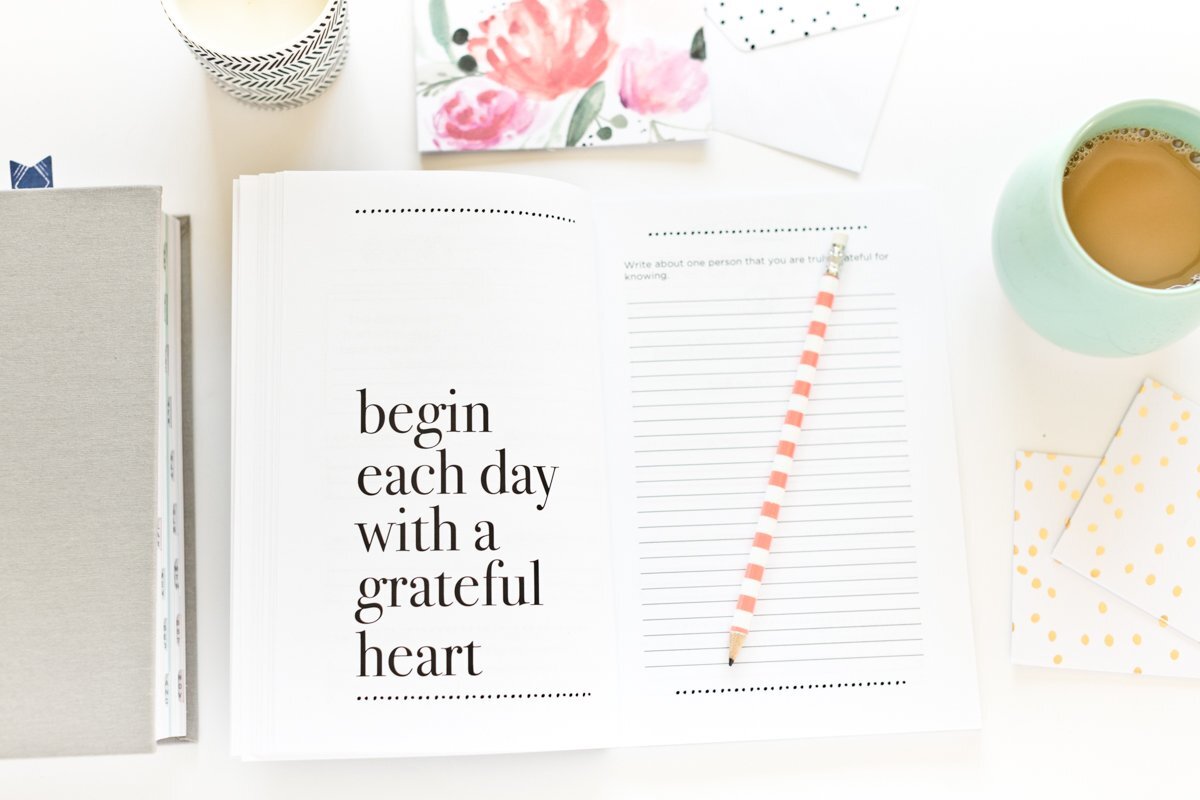How To Defeat A Negative Mindset In Five Minutes
/Using Gratitude Journaling As Self Care
Let’s be honest, we live in a crazy world. Most people are overwhelmed by some kind of stress in their daily lives, whether it be due to their job, personal life, health, relationships, life goals, or any number of other things. It can be difficult to live our best lives when our minds are weighed down by constant feelings of anxiety or depression. We may start to wonder “what’s the point?” when what we’re going through feels unmanageable. That’s not a personal judgement - it’s simply a fact of life, but that doesn’t mean we give up, does it? After all, even when things in our lives are hard, they’re never hopeless!
One simple way to quiet the chaos or calm the mind is to get your thoughts out on paper. Just being consistent and intentional about expressing what’s going on in your life in a neutral, non-threatening space can go a long way towards making your thoughts and emotions more manageable. But if you want to truly change your mindset and improve your life, the most important thing to focus on is being positive and being grateful. Ask yourself, what would change about my life if I started paying more attention to the little things I take for granted? Am I really lacking or is it simply my perspective that keeps me trapped in feelings of negativity?
How to Define Gratitude
There are many definitions of gratitude. Some define it as positive emotions, some as a personality trait; some define it as both. Many experts frame gratitude as a practice—an action we take as an expression of loving kindness. Others frame it as recognizing and mindfully appreciating the gifts given to us in our lives.
Creating a gratitude practice begins to shift your mindset toward the good things in your life. You automatically start looking for things to be grateful for, and see them more clearly and immediately. Practicing gratitude has been shown to improve mental and physical health across the board, including increasing satisfaction, happiness, and interconnectedness with loved ones and your community. Creating a gratitude practice costs nothing, and the rewards are limitless.
Gratitude journaling is a powerful way to practice thankfulness and cultivate a sense of abundance in your life.
What Is Gratitude Journaling, and Why Should You Do It?
Gratitude journaling is a powerful way to practice thankfulness and cultivate a sense of abundance in your life. The practice of therapeutic journaling helps us develop a sense that no matter what challenges we face, there is always good in life, and therefore a lot to feel thankful for. The more we remind ourselves of the good in our lives, the better equipped we will be for when we encounter bumps in the road.
Although practicing gratitude has been embedded into many religions and cultures, it has recently gained more traction as a means of therapy from a psychological and social lens. Studies are showing that writing down what you’re grateful for in your life on a regular basis reduces stress hormones in your body, which in turn leads to improved health overall. A daily journaling practice can help us adjust to not only life’s challenges, but also to big life transitions, such as moving, going to college, having a baby, etc. Not only that, but guided journaling also helps you recognize the good things in your life, as well as things you can live without.
Gratitude Journal: A Practice in Self Care
Although practicing gratitude is an important part of self-care, it is by no means a selfish act.
The great thing about practicing self-care by way of journaling for mental health is that it’s free, easy, accessible, and it brings an immediate benefit to your life by recentering your thoughts around positivity. There really is no downside to incorporating a small daily gratitude practice into your life. In fact, gratitude journaling can help foster a sense of mindfulness, because the more you do it, the better you become at noticing the (small or big) things in your life that you’re grateful for.
Although practicing gratitude is an important part of self-care, it is by no means a selfish act. The more you focus on what you’re grateful for each day, the more likely it is that you’ll be more generous with the people in your life and pay those feelings of thankfulness forward to improve the lives and wellbeing of others. This creates more positivity around you and draws people who have similar positivity traits closer to you.
A gratitude habit is infectious! Living in gratitude helps develop a greater sense of compassion and generosity toward yourself and others, will help you laugh and smile more easily, and find ways to notice the good things in life. Reconnecting to what we’re grateful for helps us feel more connected to the people and community around us, and aids in the overall sense that we aren’t alone. For that reason, therapeutic journaling can be an extremely valuable tool for anyone suffering from feelings of depression, loneliness, isolation, or neglect to refocus their energy towards positivity and begin to escape the trappings of a negative mindset.
How Is a Gratitude Journal Different From Other Guided Journals?
A gratitude journal helps list and organize objects, people, events, acts of kindness, sensations, and emotions that you feel thankful for on a regular basis in a way that’s tangible. Because inner reflection is such a big part of gratefulness, the ability to read through your past entries and reflect on all the many gifts you’ve received throughout your self-care journey is incredibly valuable in developing and maintaining an “attitude of gratitude.”
A gratitude journal can be a simple notebook, a scrap piece of paper, or whatever you can find to write on. If you love journaling in nice paper on a journal with beautiful design, there are lots of beautiful gratitude journals to choose from. There are even 5-minute gratitude journals to start small—just 5 minutes per day can make a huge impact! The best plan is that you can get started with whatever will help you keep journaling consistently, as that will build and sustain your practice over time.
The benefit of a gratitude journal is that it’s your sacred, private space of non-judgment to write down what you feel most thankful for in your life. It doesn’t matter what time of day you write down your reflections of gratitude. If you’re new to journaling as a self-care practice, guided journaling can be a great place to start. Because gratitude can have a very powerful effect on developing a feeling of abundance in life, even if you only have a few minutes a day to devote.
As gratitude journaling becomes more popular, there are many gratitude journals available to choose from. Guided journals too have shot up in popularity, but many of them don’t necessarily focus on reflections of gratitude, but rather reflecting on the day to day, planning, or even on reducing anxiety or depression. The key to finding the best gratitude journal for your needs is to first define what it is you’re hoping to get out of a daily gratitude routine and then testing out a few approaches to see which works best for you. After all, the most important ingredient in maintaining a regular gratitude practice is your commitment, so whichever option you choose, it should be one that’s easy for you to keep up on a regular basis.
Gratitude Journal Therapy: How to Get Started
There are many ways to get started on your guided journaling practice. Follow your inspiration and intuition. Here are several entry points that are easy and accessible:
What are you grateful for today? List 5 things, no matter how small, you feel thankful for today.
Write a thank you note to someone you feel grateful for this week. Consider delivering this thank you note. (The more notes you write, the more you will build better relationships with the people in your life: your coworkers, friends, family members, or partner(s).)
Think about a piece of art (a musical album, song, a book, movie, painting, garden, building, quilt…) that affected you this week. Write about how it inspires you, grounds you, or how it makes you feel. Perhaps it helped you understand your own life a bit better. Write down some reflections on the qualities of the piece of art and how it has changed your life.
Write about something beautiful in your home. Perhaps it’s a work of art, a plant, or even a color you love. What about this object or attribute is special or alluring to you?
Do your journaling at the same time every day - That way, it will be easier to remember.
Tips for Keeping Your Gratitude Journal Practice Consistent
Creating a new habit takes 2-3 weeks to solidify. If you commit to keeping a gratitude journal for a month, here are some tips to keep it consistent.
Do your journaling at the same time every day, whether it’s in the morning before breakfast or at lunch, or in the evening before bed. That way, it will be easier to remember.
If you have a hard time remembering to write in your journal, set a reminder in your phone, planner, or calendar for the same time every day.
If you decide to write in a special place, keep your gratitude journal on your desk or in that place as a visual reminder.
If you feel pressed for time or uninspired to journal one day, don’t stress or beat yourself up. Pick it back up if you missed a day, and forgive yourself for forgetting. And then tap back into the gratitude you feel for having picked it back up! This is why we call it a practice. If you only have a few minutes to write, simply write 1 small thing you feel grateful for in that moment. Even writing down just one word can be beneficial!
If you find yourself slipping off the wagon, remember to reconnect with why you decided to begin gratitude journaling. Once you tap back into your motivation, returning to the practice will become easier.
Want to join our 7-day Gratitude Journaling Challenge?
Sign up below to jumpstart your gratitude journaling practice with a full week of daily gratitude prompts delivered directly to your email each morning.
Citations:
1. https://positivepsychology.com/gratitude-appreciation/











This advent reading plan starts with readings that focus our attention on the gospel—the good news that Jesus came to die and rise from the dead so that the sins of all who repent and believe could be reconciled to God. Read along and download a free printable reading plan !